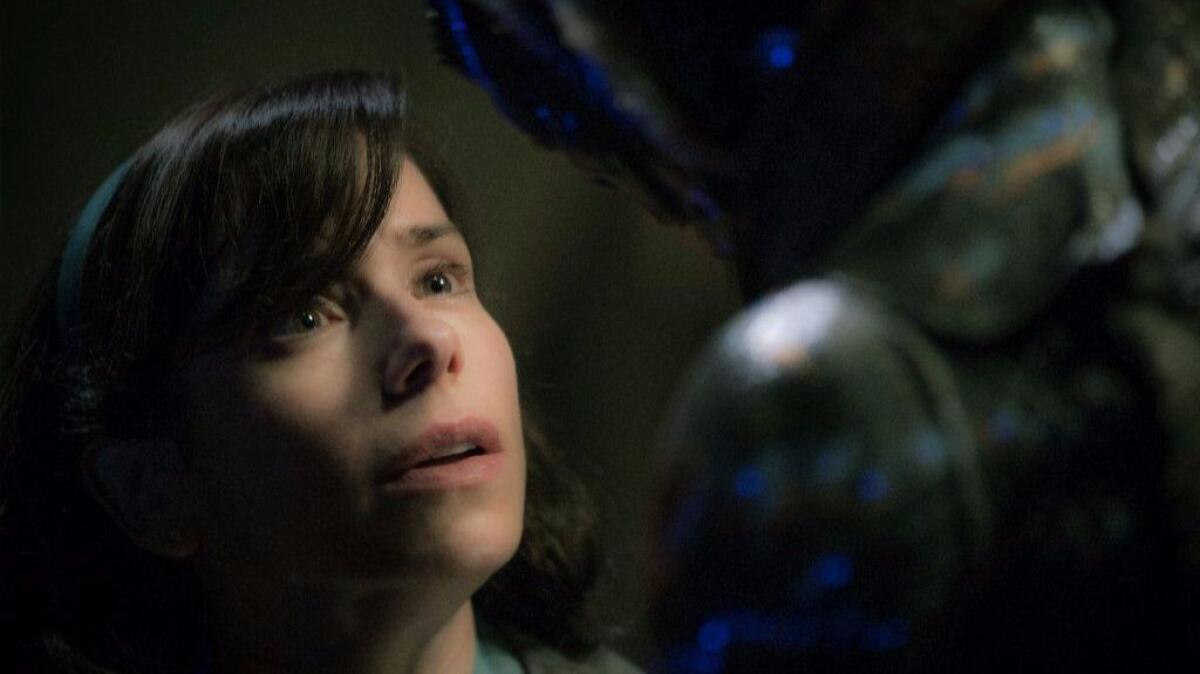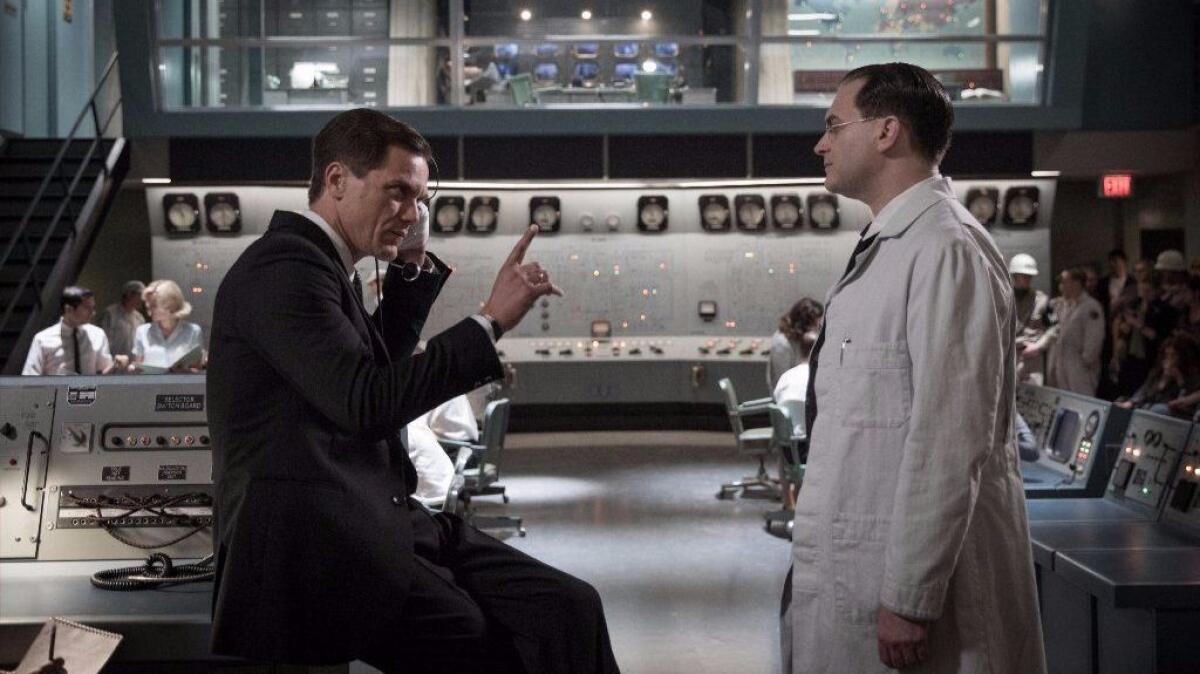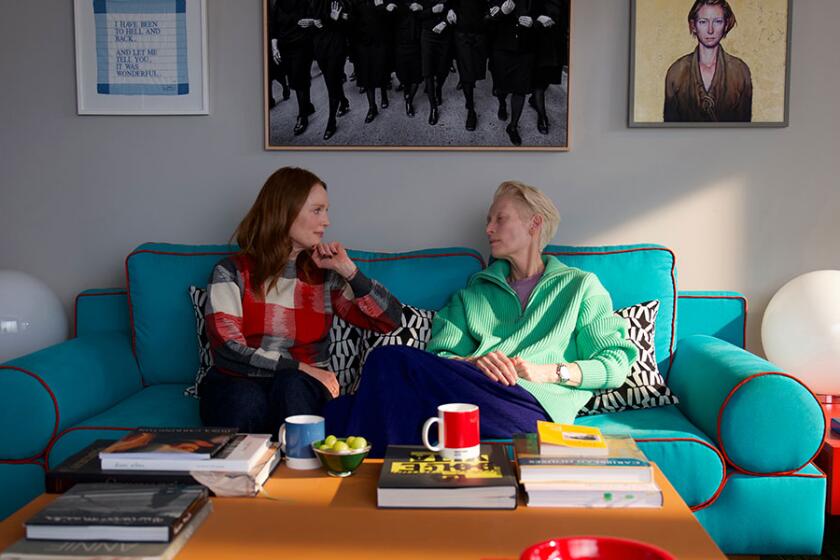Q&A: Guillermo del Toro’s highly personal monster film ‘The Shape of Water’ speaks to ‘what I feel as an immigrant’
- Share via
Throughout his career, Guillermo del Toro has bounced between large-scale studio films like “Pacific Rim” and “Hellboy” and smaller, more idiosyncratic ones like “Pan’s Labyrinth” and “The Devil’s Backbone.” His latest movie, “The Shape of Water” — the story of a mute janitor (Sally Hawkins) who falls in love with an aquatic humanoid creature being held captive in a secret government laboratory during the Cold War — is, perhaps needless to say, one of the latter. It’s also being hailed as one of his best.
Building on the raves it earned in its premiere at the Venice Film Festival, the movie — a fable of improbable love in the face of fear and intolerance — drew cheers at its first North American screening Saturday at the Telluride Film Festival. It will play the Toronto International Film Festival next, before opening Dec. 8 in the thick of awards season.
The morning after the Telluride bow, The Times sat down with del Toro to talk about what inspired his surreal adult fairy tale and why its fantastical, period-set, beauty-and-the-beast story is all too relevant in today’s real world.
Your friend and fellow director Alejandro Iñárritu has said that he thinks “The Shape of Water” is your most personal movie. Do you agree?
It’s the movie that I like the most. It’s this one, then “The Devil’s Backbone,” then “Pan’s Labyrinth,” then “Crimson Peak,” and so on and so forth. That’s the order for me — it doesn’t mean people have to agree. It’s sort of the aim-and-target quotient for a filmmaker — did it land where I wanted it? This landed exactly where I wanted it.
Oscar buzz and movie love mingle at the Telluride film festival »
But “most personal” also suggests that, of all the films you’ve done, there’s the most of you in this one.
There is the most of me. Most of the time — in “Pan’s Labyrinth” or “Devil’s Backbone” — I’m talking about my childhood. Here, I’m talking about me with adult concerns. Cinema. Love. The idea of otherness being seen as the enemy. What I feel as an immigrant. What I feel is an ugly undercurrent not in the past — not in the origins of fascism — but now.
It is a movie that talks about the present for me. Even if it’s set in 1962, it talks about me now.
Some people find Jesus. I found Frankenstein. The reason I'm alive and articulate and semi-sane is monsters.
— Guillermo del Toro
That era is often depicted through a nostalgic prism as somehow being the good old days. But this movie paints a very different picture, bringing out the undercurrent of fear and intolerance.
I think when people say “Make America Great Again,” they’re thinking of that America, which actually never ended up really crystallizing. If you were a white Anglo-Saxon Protestant, then things were great. You had jet-fin cars, super-fast kitchens. But everyone else didn’t have it so good. And the creature sort of represents everybody else.
Obviously the world has changed dramatically since you were shooting this film. I can’t imagine you could anticipate the way those themes would resonate ...
I did. And the reason why is that I’m Mexican. I’ve been going through immigration all my life, and I’ve been stopped for traffic violations by cops and they get much more curious about me than the regular guy. The moment they hear my accent, things get a little deeper.
I know it sounds kind of glib, but honestly, what we are living I saw brewing through the Obama era and the Clinton era. It was there. The fact that we got diagnosed with a tumor doesn't mean the cancer started now.
Hopefully one of the things the movie shows is that from 1962 to now, we’ve taken baby steps — and a lot of them not everyone takes. The thing that is inherent in social control is fear. The way they control a population is by pointing at somebody else — whether they’re gay, Mexican, Jewish, black — and saying, “They are different than you. They’re the reason you’re in the shape you’re in. You’re not responsible.” And when they exonerate you through vilifying and demonizing someone else, they control you.
I think the movie says that there are so many more reasons to love than to hate. I know you sound a lot smarter when you’re skeptical and a cynic, but I don’t care.

Going back to the beginning, what was the initial germ of this movie?
I’ve had this movie in my head since I was 6, not as a story but as an idea. When I saw the creature swimming under Julie Adams [in 1954’s “Creature From the Black Lagoon”], I thought three things: I thought, “Hubba-hubba.” I thought, “This is the most poetic thing I’ll ever see.” I was overwhelmed by the beauty. And the third thing I thought is, “I hope they end up together.”
I kind of doubt that’s what most 6-year-olds were thinking.
No, I’m a weird one.
Is there part of you that feels like, as soon as there’s a monster or any fantasy or genre element in a movie, it automatically gets put in a box and isn’t taken seriously?
Oh, for sure. But that would be important if I cared — but I don’t.
Look, I’ve been doing this for 25 years. If I thought it was not the route to go, I would have changed. To me, the genre is my Campbell’s Soup can if I was [Andy] Warhol, or my comic book vignette if I was [Roy] Lichtenstein.
We forget that the primal motor of storytelling is fable and parable. I don’t come at it from an illiterate or a pop point of view. I come at it with every literary tool I can, every artistic tool I can. I truly try to create beauty and reflection and all of that as conscientiously and judiciously and minutely as I can. And then it’s up to people.
But you’re not on a mission to change the way people see genre?
No, I can’t. I know that what I saw when I was a kid had redemptive powers. Some people find Jesus. I found Frankenstein. And the reason I’m alive and articulate and semi-sane is monsters. It’s not an affectation. It’s completely, spiritually real to me. And I’m not going to change.
This movie has a real spirit of innocence and old-fashioned romance, but at the same time, there are aspects that are very adult and sometimes jarring. The first time we see Sally Hawkins’ character, for example, she is masturbating.
Well, to me, there is no perversion in sex if you’re not perverse. You can do whatever you want and as long as you do it in the most beautiful way, it doesn’t matter. A woman masturbating makes it clear to you that this is not your regular Disney princess.
The movie is in love with love and in love with cinema. Sex, violence — whatever it is — the spirit of the movie is so gentle. I wouldn’t recommend it for kids, but for adolescents, it’s a beautiful movie. It’s sort of liberating.

And because you were making it on a budget of under $20 million, no one told you, “Let’s make this safer and more broadly appealing”?
Never. That was the point. The reason why the exercise of cramming a $60-million movie into a $19.5-million budget is worth it is that you get the freedom. I think that money takes freedom away. More money, less freedom.
So as you go on, are you finding yourself pulled more away from the part of the business where there are those kinds of money pressures? If you were approached to direct a tentpole that had to be a huge, four-quadrant blockbuster, like a mainstream superhero movie or a “Star Wars” movie ...
If I choose a franchise of that size, I try to make sure that we’re aligned — and if we’re not, I walk away.
I have been offered massive stuff, and I’ve turned it down. Why? Because, (a), I live a very sort of simple life. I dress like [garbage]; I drive a 4-year-old car; I spend all my money on rubber monsters. So I’m OK. [Laughs] And also I have this idea that if you do movies for any other reason than the stories, you’re screwed. It means something just gave in.
Only good movies
Get the Indie Focus newsletter, Mark Olsen's weekly guide to the world of cinema.
You may occasionally receive promotional content from the Los Angeles Times.








